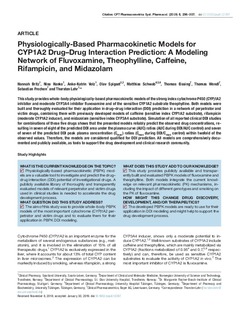| dc.contributor.author | Britz, Hannah | |
| dc.contributor.author | Hanke, Nina | |
| dc.contributor.author | Volz, Anke-Katrin | |
| dc.contributor.author | Spigset, Olav | |
| dc.contributor.author | Schwab, Matthias | |
| dc.contributor.author | Eissing, Thomas | |
| dc.contributor.author | Wendl, Thomas | |
| dc.contributor.author | Frechen, Sebastian | |
| dc.contributor.author | Lehr, Thorsten | |
| dc.date.accessioned | 2020-02-06T07:09:17Z | |
| dc.date.available | 2020-02-06T07:09:17Z | |
| dc.date.created | 2019-09-13T14:01:01Z | |
| dc.date.issued | 2019 | |
| dc.identifier.citation | CPT: Pharmacometrics and Systems Pharmacology. 2019, 8 (5), 296-307. | nb_NO |
| dc.identifier.issn | 2163-8306 | |
| dc.identifier.uri | http://hdl.handle.net/11250/2639905 | |
| dc.description.abstract | This study provides whole‐body physiologically‐based pharmacokinetic models of the strong index cytochrome P450 (CYP)1A2 inhibitor and moderate CYP3A4 inhibitor fluvoxamine and of the sensitive CYP1A2 substrate theophylline. Both models were built and thoroughly evaluated for their application in drug–drug interaction (DDI) prediction in a network of perpetrator and victim drugs, combining them with previously developed models of caffeine (sensitive index CYP1A2 substrate), rifampicin (moderate CYP1A2 inducer), and midazolam (sensitive index CYP3A4 substrate). Simulation of all reported clinical DDI studies for combinations of these five drugs shows that the presented models reliably predict the observed drug concentrations, resulting in seven of eight of the predicted DDI area under the plasma curve (AUC) ratios (AUC during DDI/AUC control) and seven of seven of the predicted DDI peak plasma concentration (Cmax) ratios (Cmax during DDI/Cmax control) within twofold of the observed values. Therefore, the models are considered qualified for DDI prediction. All models are comprehensively documented and publicly available, as tools to support the drug development and clinical research community. | nb_NO |
| dc.language.iso | eng | nb_NO |
| dc.publisher | iley Periodicals, Inc. on behalf of the American Society for Clinical Pharmacology and Therapeutics. | nb_NO |
| dc.rights | Navngivelse-Ikkekommersiell 4.0 Internasjonal | * |
| dc.rights.uri | http://creativecommons.org/licenses/by-nc/4.0/deed.no | * |
| dc.title | Physiologically-based pharmacokinetic models for CYP1A2 drug-drug interaction prediction: A modeling network of fluvoxamine, theophylline, caffeine, rifampicin, and midazolam | nb_NO |
| dc.type | Journal article | nb_NO |
| dc.type | Peer reviewed | nb_NO |
| dc.description.version | publishedVersion | nb_NO |
| dc.source.pagenumber | 296-307 | nb_NO |
| dc.source.volume | 8 | nb_NO |
| dc.source.journal | CPT: Pharmacometrics and Systems Pharmacology | nb_NO |
| dc.source.issue | 5 | nb_NO |
| dc.identifier.doi | 10.1002/psp4.12397 | |
| dc.identifier.cristin | 1724504 | |
| dc.description.localcode | This is an open access article under the terms of the Creative Commons Attribution‐NonCommercial License, which permits use, distribution and reproduction in any medium, provided the original work is properly cited and is not used for commercial purposes. | nb_NO |
| cristin.unitcode | 194,65,15,0 | |
| cristin.unitcode | 1920,14,0,0 | |
| cristin.unitname | Institutt for klinisk og molekylær medisin | |
| cristin.unitname | Laboratoriemedisinsk klinikk | |
| cristin.ispublished | true | |
| cristin.fulltext | original | |
| cristin.qualitycode | 1 | |

